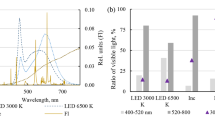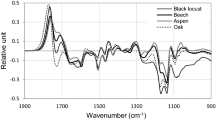Summaries
Fourier transform-infrared (FT-IR) micro-spectroscopic depth profile analysis was used to monitor the penetration of photo-induced chemical changes in Japanese cedar earlywood, exposed for up to 1500 hours of artificial sunlight emitted by a xenon lamp producing 375W/m2 of radiation (within the 300 to 700nm spectral range). Parallel experiments assessed the transmission of ultraviolet (UV)-near UV and UV-visible light through Japanese cedar earlywood (both unexposed and pre-exposed to 1000 hours of artificial sunlight). Infrared (IR) spectra showed that photo-induced chemical changes penetrated into the earlywood to a depth of up to 700µm and there was a logarithmic increase in the depth of degradation as a function of irradiation time. The penetration of light into wood showed an exponential decrease with wood depth. Nevertheless, sufficient photochemically active light may be present at depths, which could account for photodegradation depth profiles that were observed.
Résumé
On a employé l’analyse de profil en profondeur micro-spectroscopique transformation de Fourier-infrarouge (FT-IR) pour surveiller la pénétration des changements chimiques et photo-induits dans le bois de printemps du cèdre japonais qui a été exposé pendant jusqu’à 1500 heures à la lumière de soleil artificielle émise par une lampe 375W/m2 xenon (dans la fourchette du spectre 300 à 700nm). En même temps on a monté des expériences pour évaluer la transmission de la lumière ultraviolet (UV), UV-proche et UV-visible à travers le bois de printemps du cèdre japonais (et les échantillons non exposés et les échantillons qui avaient été pré-exposés à 1000 heures de lumière de soleil artificielle). Les spectres infrarouges (IR) ont montré que les changements chimiques et photo-induits ont pénétré dans le bois de printemps jusqu’à des profondeurs qui pouvaient atteindre 700µm etil y avait un accroissement logarithmique de la profondeur de la dégradation en fonction du temps d’irradiation. La pénétration de la lumière dans le bois a montré un décroissement exponentiel au fur et à mesure que la profondeur augmentait. Néanmoins il est possible qu’il y ait assez de lumière qui soit photochimiquement active au fond du bois pour expliquer les profils en profondeur de la photodégradation qui ont été observés.
Zusammenfassung
Wir studierten die Penetration von lichtausgelösten chemischen Veränderungen in Japanischem Zederfrühholz, das für 1500 Stunden artifiziellem Licht ausgesetzt worden war, mittels einer Fourier Transform-Infrarot (FT-IR) mikro-spektroskopischen Tietenprofilanalyse. Das Kunstlicht kam von einer Xenon-Lampe mit einer Leistung von 375W/m2 in der 300–700nm Wellenlänge. In einem Parallelexperiment bewerteten wir die Transmission von ultravioletter (UV) Strahlung, UV-naher Strahlung und sichtbarem UV-Licht auf Japanisches Zederfrüholz (sowohl Holz, das noch keinem Sonnenlicht ausgesetzt war als auch Holz, das 1000 Stundem künstlichem Licht ausgesetzt war. Das Infrarotspektrum zeigte uns, daß die fotoinitiierten Veränderungen bis zu einer Tiefe von 700 µm im Holz zu finden waren. Wir fanden darüberhinaus, daß die Degradadtionstiefe logarhythmisch mit der Bestrahlungszeit zunahm. Die Lichtpenetration nahm mit der Holztiefe exponentiell ab. Trotzdem ist es möglich, daß genug fotochemisch aktives Licht bis in tiefere Schichten durchdrang, was die beobachteten Fotodegradationstiefenprofile erklären könnte.
Similar content being viewed by others
References
Feist W C and D N-S Hon, ‘Chemistry of weathering and protection’,The Chemistry of Solid Wood, (ed) R Rowell, 401, American Chemical Society, Washington DC, 1984
Evans P D, ‘Wood products: Weathering’,The Encyclopaedia of Materials Science and Technology, (eds) K H T Buschow, R W Cahn, M C Flemings, B lischner, E J Kramer and S Mahajen, 6, Elsevier Science, Oxford, 2001
Hon D N-S and G Ifju, ‘Measuring penetration of light into wood by detection of photo-induced free radicals’,Wood Sci,11, 118–27, 1978
Browne F L and H C Simonson, ‘The penetration of light into wood’,Forest Prod J,7, 308–14, 1957
Schramm W H, ‘Jahresber’,Vereiningun Angew Bot,3, 116–53, 1906
Bamber R K and R Summerville, ‘Microscopic studies of the weathering of radiata pine sapwood’,J Inst Wood Sci,9, 84–7, 1980
Yata S and T Tamura, ‘Histological changes of softwood surface during outdoor weathering (in Japanese)’,Mokuzai Gakkaishi,41, 1035–42, 1995
Horn B A, J Qiu, N L Owen and W C Feist, ‘FT-IR studies of weathering effects in western red cedar and southern pine’,Appl Spectrosc,48, 662–8, 1994
Derbyshire H and E R Miller, ‘The photodegradation of wood during solar irradiation. Part 1. Effects on the structural integrity of thin wood strips’,Holz Roh-Werkst,39, 341–50, 1981
Kataoka Y and M Kiguchi, ‘Depth profiling of photo-induced degradation in wood by FT-IR microspectroscopy’,J Wood Sci,47, 325–7, 2001
Kataoka Y and T Kondo, ‘FT-IR microscopic analysis of changing cellulose crystalline structure during wood cell wall formation’Macromolecules,31, 760–4, 1998
Tolvaj L and O Faix, ‘Artificial aging of wood monitored by DRIFT spectroscopy and CIE L*a*b* color measurements’,Holzforschung,49, 397–404, 1995
Kimura F, T Kimura and D G Gray, ‘FT-IR study of the effect of irradiation wavelength on the colour reversion of thermomechanical pulps’,,48, 343–8, 1994
Hon D N-S and S T Chang, ‘Surface degradation of wood by ultraviolet light’,J Polym Sci Part A,22, 2227–41, 1984
Anderson E L, Z Pawlak, N L Owen and W C Feist, ‘Infrared studies of wood weathering. Part I: Softwoods’,Appl Spectrosc,45, 641–7, 1991
Evans P D, A J Michell and K J Schmalzl, ‘Studies of the degradation and protection of wood surfaces’,Wood Sci Technol,26, 151–63, 1992
Hon D N-S and W C Feist, ‘Hydroperoxidation in photoirradiated wood surfaces’,Wood Fiber Sci,24, 448–55, 1992
Vink P, ‘Photo-oxidation of polypropylene’,J Appl Polym Sci Appl Polym Symp,35, 265–73, 1979
Author information
Authors and Affiliations
Corresponding author
Rights and permissions
About this article
Cite this article
Kataoka, Y., Kiguchi, M. & Evans, P.D. Photodegradation depth profile and penetration of light in Japanese cedar earlywood (Cryptomeria japonica D. Don) exposed to artificial solar radiation. Surface Coatings International Part B: Coatings Transactions 87, 187–193 (2004). https://doi.org/10.1007/BF02699634
Published:
Issue Date:
DOI: https://doi.org/10.1007/BF02699634




